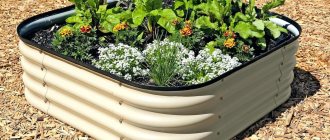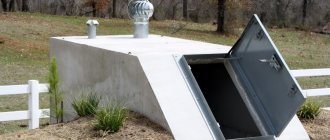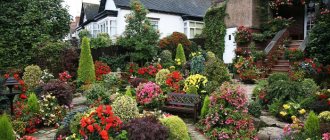Any owner of a country house who has ever seen an alpine hill will definitely be inspired by the idea of building the same miracle on their property. Flora lovers will be interested in the orderly pile of stones and artificially created terraces, full of bright flowers and soft grass cushions.
Only a lazy summer resident will not be able to build a rock garden, and a person’s lack of experience will only encourage him to do so.
It’s not difficult to recreate a mountain landscape in miniature; you just need to know a few rules, prepare natural materials and be patient. Because construction takes a lot of time.
By the way, if you are choosing a landscape design studio, I recommend the guys from Kontur. There is a calculator on the site. Move on!
Mountain landscape "at home"
Despite the growing interest in alpine slides and numerous photographs with its images, it is sometimes confused with rockeries. What are their differences?
It got its name from the English word rock—rock, stone, and it is a garden of rocks, diluted with rare low-growing plants.
In the composition of pebbles, the emphasis is on their beauty and diversity. While in an alpine slide the boulders serve to create a background and natural composition, the main attention is paid to the flowers.
The rock garden imitates a mountain landscape, in which low-growing plants mixed with stones form natural grass clearings.
We recommend reading:
- Effective Weed Killer - Review of the Best Weed Removal Products and Methods. Geotextiles and rules for their installation (145 photos and videos)
- Flowers for a flower bed that bloom all summer - a review of unpretentious types of flowers for the whole summer (85 photos)
- Do-it-yourself trellis - 110 photos on how to make it yourself and video tips for use in landscape design
Modern summer residents will certainly prefer a stepped rocky flower bed to a traditional flower bed.
How to make and decorate an alpine slide with a pond?
Scheme of a pond for an alpine slide Alpine slide with a pond
To build an alpine slide with a pond you need the following:
- We dig a pit about 0.5 m deep.
- We fill the bottom with sand, 0.1 m thick, and compact it.
- We lay geotextiles on the bottom, and on top of it a waterproofing film (butyl rubber material). The service life of such film is 20-30 years.
- The entire pit should be covered with film and extend beyond it by 30-40 cm.
- We place stones along the edges of the pond so that the film is not visible anywhere.
- We fill the pond with water from a hose and spread the film in the water. The pond is ready.
Basic postulates
When choosing a place in the country for an alpine slide, experienced designers advise paying attention to the following factors:
- the basic principle of building a rock garden is the absence of symmetry, the design of two or three differences in height;
- choose a place with maximum sun exposure. Its deficiency will lead to the loss of bright colors in the flower garden and, in addition, the plants will stretch out, become thinner, and the stone garden will lose its attractiveness;
- proximity to trees will bring unnecessary trouble, as falling leaves will spoil the appearance of the alpine slide;
- when arranging, rely on stones of unusual shapes. If they are gray, surround them with bright colors.
Whatever type of rocky flowerbed you choose, you will need a standard set of plants and stones.
Arranging an alpine hill with flowers and plants
In order for the slide to have a pleasant and attractive design appearance, many varieties of vegetation are used during its construction.
Their numbers and types can be different, which the owners of their summer cottage like. When choosing them, you should pay attention to weather conditions, the type of plants that grow in that area, and many other factors.
And also, before purchasing plants or flowers, you need to contact a person with knowledge in botany, and it is recommended to contact landscape designers, only they have experience in this field.
If you choose plants yourself, you risk simply destroying the plants. Also, when forming an alpine slide, you can use small ornamental trees. You need to use bright, saturated flowers that look great on the site, delighting with their beautiful appearance.
Stone, flowers and water
The basic principle of a rock garden is the arrangement of flowers and stones: the largest stones are located at the top, creeping types of flowers and small stones live at the foot.
The slide always (except in winter, of course) looks original and compact. Flowers can be placed on artificial terraces seasonally.
And the rock garden also surprises owners as an unusual landscape find: it is created not only in the form of a flower bed, but also on a terrace, porch or in a flowerpot.
We recommend reading:
Laying artificial turf with your own hands: how to choose and step-by-step description of how to lay a lawn (100 photos)How to lay rolled lawn - step-by-step master class and tips on how to lay rolled lawn correctly (120 photos + video)
The best flower clock - a step-by-step description of how to make a beautiful element of landscape design correctly
If space, time and technical means allow, the owners create a slide and a pond in the complex. Sometimes even with a waterfall. To do this, you will need certain tools, an old bathtub or other container, and special instructions from the Internet.
We won’t go into detail here; our task is to tell you how to make an alpine slide in the easiest way.
To start arranging a rock garden, a summer resident needs to decide which option he would like to see on his site:
- an alpine slide in a flowerpot is an original solution for a summer house with a small piece of land. The mobile structure can easily be moved indoors for the winter;
- a typical rock garden is located in terraces in open space;
- the third option is the most time-consuming, but also the most effective: a rocky flowerbed with a pond, waterfall or fountain.
Types of alpine slides - container rock gardens
A variety of container rock gardens have been the most popular among gardeners in Europe throughout the twentieth century, starting in the 1930s. First of all, because such rock gardens are extremely practical. They can be installed not only in suburban areas, but also in the courtyard of a city house, and even on the balcony. In addition, well-drained containers allow even the most demanding plants to easily tolerate winter discomfort.
Selecting a location
The technology for creating a rock garden involves a phased division of work.
To avoid mistakes when arranging it, novice gardeners are advised to follow the step-by-step instructions.
Find a place for the future flower garden away from trees and drainpipes. In the first case, the foliage will cover the rocky garden, in the second, the water will wash away our structure.
We recommend reading:
- Creepers for the garden - a review of the best climbing flowers and popular types of plants for the garden and landscape design (120 photos)
Rules for whitewashing trees - a step-by-step description of whitewashing and methods for quickly processing garden trees (115 photos)
Which flowers are the most unpretentious? Review of the most beautiful and easy-to-care plants for the garden or landscape design (105 photos)
If there is a slope at your summer cottage, it will be an ideal place for an alpine slide. It is easy to recreate terraces here and even build a small waterfall. On a level area, an embankment of soil and stones is created artificially.
To avoid mistakes with sizes, landscape designers recommend sticking to a percentage ratio of 1:10. That is, if the plot is 6 acres, a rock garden with a height of 60-100 cm does not go beyond the boundaries of 6-8 square meters.
Preparatory work: where to start creating an alpine slide
When creating a beautiful rock garden in your garden, you need to carefully think through all the nuances and develop a plan.
You need to understand:
- What kind of alpine slide are you going to create?
- Where will you place it?
- When to start work
In the next part of the article, we will tell you about the types of rock gardens and advise where and when it is best to make them.
How to choose an alpine slide design
There are a lot of types and designs of rock gardens. There is no single classification here. Traditional alpine slides and ordinary rocky flower beds are often combined under the same name. We have collected the most popular varieties used by landscape designers.
There are such options for rock gardens:
- Rocky slide This is the easiest option. Large boulders are placed in the center and at the base. The slopes are made of fine gravel and crushed stone. Climbing plants and small bushes are planted between them. A hill can be made from soil and planted with flowers and herbs. Stones in such a composition will play a supporting role.
- European Hill Bright perennial flowers predominate here, and the stones only emphasize their beauty. Sometimes such compositions are called alpine lawns.
- English Hill Coniferous bushes and trees (juniper, dwarf pine, spruce), heather and other plants with small flowers are planted here. They are supplemented with a scattering of small and medium stones.
- Mountain slope Such an alpine slide can be made on a natural hill, near the fence in the country. It imitates a mountain or hill with a landslide. Large boulders are laid out at the foot, and the slope itself is covered with fine gravel or crushed stone. An obligatory element of the composition is dwarf pines or spruces. On the slope you can plant edelweiss, heather, saxifrage, sedge, and other low-growing or creeping species.
- Terraced slope It consists of terraces of different widths and lengths. They can be supplemented with a mountain path or steps. Most often, flat shales, sandstone, and limestone are used for the composition. In some places they make an embankment of small stones, simulating a collapse. Low-growing climbing plants are planted on the terraces, with conifers or junipers on the top.
- Rock cliff To create such an alpine slide, you need flat stones, cubic or rectangular boulders, and rubble stone. A vertical wall is laid out of them, and a backfill of fine gravel is made at the foot. Flowers (bells, edelweiss, heather) are planted on the top. You can cover it with a layer of lawn grass and decorate it with a juniper bush. Several green climbing plants are placed between the stones (but they should not hide the rock relief). On the opposite side, you can make a gentle slope with stones and herbaceous plants.
- Alpine valley This rock garden is placed on a flat area or a small slope. The stones are dug into the ground 2/3, at some distance from each other. You can lay paths between them, plant bright flowers or bushes, coniferous trees, or create a dry stream.
- Gorge This is a rather complex composition that can be created in a natural ravine or relief depression. Sometimes drainage channels are created under the gorge. The walls are laid out asymmetrically with stones, and a real or dry stream flows along the bottom. Trees and most plants are planted along the edge; several climbing species can be placed on the walls.
- Forest ravine Its shape resembles a gorge. The main difference between this rock garden is the minimal use of stones. The walls of the ravine are planted with grass, ferns, moss or lichens. Coniferous or deciduous (beech, ash) trees and shrubs should grow on top. You can fill the bottom of the ravine with stones, and bury several boulders at the base or at the top.
- Water cascade The basis is a terraced slope made of flat slabs and boulders. A system of pipes is placed between the stones through which water will flow. It flows down the slopes into a small artificial pond or canal. You can make a drainage system like a cascade slide. The canal is designed in the form of a mountain gorge, with pipes leading to the slopes. Marsh plants are planted along the edges.
- Swamp in the mountains This option is suitable for a wetland or a combination with a small artificial pond. Marsh plants are planted in the center. Boulders and small pebbles are placed between them. The edges of the swamp are shaped by sedge, reeds, irises, large stones and a scattering of pebbles.
- Rockery, or Japanese garden Rockery occupies a larger area than an ordinary alpine hill. The main emphasis here is on the stones, and the plants play a secondary role. Each boulder must be unique and special in shape, color, texture. Its surface is often covered with moss. The composition is complemented by grottoes, cascades, and stone lanterns.
- Czech rolling pin This is an interesting type of rock garden, in which only flat stone slabs of slate, dolomite, sandstone, and limestone are used. They are placed edgewise at a certain distance from each other, sprinkled with earth and sand. Moss, ferns, evergreens and low-growing flowers are planted between the slabs.
- Architectural rock garden This alpine hill resembles old ruins. It can be decorated in the style of antiquity or the Middle Ages. In the first case, the basis of the composition will be columns and shards of old ceramic vases. In the second, a piece of the castle wall with an arched window or loopholes is laid out from stones or bricks. The area around is covered with fine crushed stone or gravel, and plants characteristic of wastelands are planted. Several branches of ivy are planted on the wall.
- Mixborder This is a ridge of stones of different sizes and shapes, laid out along a path or fence. Boulders need to be firmly dug into the ground. In some places you can make terraces and plant them with low-growing or ground cover plants. Flower beds with bright flowers are placed near the mixborder.
- Stone wall This kind of alpine hill is erected instead of a fence dividing the area into different zones. They make neat masonry from flat stone slabs or cubic crushed stone. The top should be uneven, imitating a dilapidated rock or fence. There you can plant several hanging plants and grass.
- Miniature rock garden in a tub If there is little space on the site, you can make a small alpine slide in any container. Wooden or stone tubs, ceramic pots, old basins, troughs, and sinks are used. A miniature rock garden can even be installed on the windowsill of an apartment. The principle remains the same - plants combine comfort with stones. Only the elements of the composition in this case are much smaller.
How to navigate such a variety of types of alpine slides and choose the right one? We have selected several recommendations for you that will help you not get lost.
Useful tips for choosing an alpine slide and its design:
- Make the most of the natural landscape features. The pit can be disguised as a forest ravine, the drainage as a gorge, and a mountain slope can be made on a small hill.
- In a small area, a vertical composition (rocky hill, rocky cliff, terrace) looks best. But its height should not exceed 5 0-80 cm.
- If you have a spacious garden with a slight slope, you can create a composition in the shape of an Alpine valley.
- A stone wall or gorge will help to divide the area into functional zones.
- Architectural rock garden and Japanese rock garden should be combined with the style of the house. Medieval ruins can coexist with massive buildings, and a Japanese garden will look best next to a one-story house with a wide roof.
- If you do not have much experience, choose simple options - an alpine valley, a rocky hill, a Czech rolling pin.
In the next part we will help you choose the right place for your rock garden.
Where to place an alpine slide: choosing a location
How well the composition will look in the garden and how the plants will behave depends on the correct choice of place for the alpine slide. In this case, you should take into account the landscape of the territory, the location of buildings, lighting, and soil type.
The rock garden can be placed:
- On the slope of a natural hill
- On level ground
- In a hole or ravine
- In the drainage channel
- In the center of the lawn
- In the backyard
- In front of the house facade
- Near an artificial pond
- Against a wall or fence
- In a shaded or illuminated area
The location influences the choice of the type of alpine slide, plants, and size of the composition.
When choosing a location, consider the following nuances:
- The optimal place for a slide in the garden is a small hill. If the area is flat, you should make the hill yourself. Its slope should face south or east.
- It is best to place the slide near a water source to make it easier to water.
- All parts of the slide should be well illuminated by the sun, then the plants will feel good. If the area is completely shaded, focus the composition on stones, mosses and lichens, and shade-loving species.
- The rock garden should look beautiful and be clearly visible from anywhere in the garden. It is not recommended to do it near walls or fences. This location option is possible only in a small area when there is no other free space.
- If the only free space on the site is near a fence or wall, they need to be masked. To do this, plant climbing plants that will shade the stone landscape and cover the fences.
- Do not place the rock garden on the leeward side. In summer, the soil here dries out quickly.
- Do not make the composition near the house or outbuildings. Rainwater and snow accumulate in such places. The soil under heavy stones will subside and the structure will quickly collapse.
- An alpine slide under deciduous trees is also not the best option. In the fall it will be difficult to collect fallen leaves from it. The only exception is a forest ravine with a minimum number of stones in the composition.
Once the design and location have been chosen, you can begin arranging the rock garden. But first, we will tell you what time of year is best to start working.
When is the best time to build an alpine slide?
There are 3 seasons that are most suitable for gardening:
- Autumn
- Spring
- Summer
In winter, working outside is uncomfortable, there is snow. In addition, frozen ground is unlikely to be excavated without special heating, and this will incur additional costs.
Any of the listed three periods is suitable for arranging a rock garden. Just consider the following nuances:
- Autumn is the most optimal period to start creating a rock garden. At the end of September you can arrange the foundation, and in October, when the soil has subsided, move on to creating a rocky landscape. Plant trees in late fall. It is better to complete the process by planting flowers in the spring.
- Spring is suitable for planting annuals and some perennials. Work can begin in early April to give the soil time to settle under the weight of the stone structure. Planting of plants and laying out stones begins only after 3-4 weeks. The main inconvenience is that in our region April can be cold, there may still be snow, and the soil at depth remains frozen. Besides, in any case, you will need a month for the slide to settle. If you rush, the composition will become deformed or partially collapse over time.
- It is not recommended to plant plants in the summer; only some species of shrubs and trees will take root. If you want to build a slide at this time of year, you will have to wait until spring or late fall to complete the job. All this time the site will look like a construction site.
Next we will tell you what tools and supplies you will need. Every summer resident has some of them, some will have to be purchased.
Selection of stones
Is it worth mentioning that when building a natural mountain landscape, only natural materials are suitable. Only garden figurines can be artificial to decorate the finished slide.
For the rock garden, durable and moisture-resistant stones are selected. Granite and large crushed stone are suitable. And layered sandstone perfectly imitates mountain ledges.
The process of creating a mini rock garden
Not everyone knows how to make a small alpine slide with their own hands. It cannot be a simple collection of rocks interspersed with vegetation. Carefully prepare the space, think through the nature of the composition.
The process of creating a small alpine slide is divided into several steps:
- Choosing a sufficiently illuminated area where water will not stagnate;
- Removing vegetation (it is advisable to cut the turf) and removing 5-10 cm of soil (neutralizes the appearance of weeds);
- Laying crushed stone, sand or brick debris for drainage;
- Backfilling with soil mixture (humus, loam, sand) to a depth of 20-25 cm while simultaneously laying the most bulky boulders buried two-thirds into the ground;
- Compacting the soil, watering it and leaving it to shrink for a week;
- Adding mulch to better absorb precipitation or filling it with fine decorative stones and creating the outline of an alpine hill.
The process is reminiscent of arranging multi-tiered compositions, but each stage is repeated, constructing a pyramidal slide. In this case, the stones are laid around the perimeter with backfilling of the inner part - the center. A similar scheme works in areas with slopes of different levels. Here you can place a beautiful path-steps made of smooth stone.
Selection of stones
The choice of stone is a decisive issue. If the area is so small that it cannot accommodate several boulders, you can limit yourself to one stone or choose options with smooth, small stones of similar size.
You can also read “Using stones in site design”
Stones of calcareous origin have a porous structure, into which it is easy to place small green inclusions without any effort, and this does not require a significant amount of soil mixture. Sandstones, like stones for a small alpine slide, will also easily fit into the landscape. But you should remember the rule about the compatibility of a panorama and a rock garden.
If it is impossible to select the appropriate type of stone, you can experiment with vegetation. Shrubs or plants with broad foliage make an excellent backdrop for boulders.
Rocky-flower composition
Construction begins in the spring or summer, so that by autumn its formation is completed and the flowers have time to take root.
A pit is dug 20 cm deep.
If you want to decorate a rock slide with a small pond, now is the time to install it. The presence of an artificial lake will significantly enliven the overall appearance of the slide. Tips on setting up a mini-pond can be found in many articles.
The bed under the rock garden is filled with fine pebbles in a layer of 15-20 cm. Broken bricks and construction waste (of course, without harmful impurities) are suitable for this purpose.
A layer of fertile soil with the addition of fine gravel is poured on top. To compact the layers of soil and drainage, they are filled with water. This is done to ensure that the structure does not sag over time.
Next, the stones are installed. Please note that the principle of building an alpine slide is based on descending. The largest boulder is located at the top, the smallest ones are at the foot. The higher the composition, the more stones are used to create it.
Installing large boulders and layered terraces will require holding them together with cement or clay mixed with soil.
Repeat the mountain landscape by creating a copy of it on your site. Model tiny gorges, plateaus, cliffs, cliffs and terraces on the slide.
How to make and decorate a small mini alpine slide: diagram, description, photo
Mini alpine slide
We start creating an alpine slide in early autumn . Before spring, when plants are planted, the stones and soil must settle.
The mini alpine slide will be about 1 m high.
Let's start making a mini slide:
- We mark the boundary of the future slide on the ground using pegs.
- We stretch the twine between the stakes.
- We tear off the grass and dig a pit 30-35 cm deep throughout the entire area, secured with twine, and cover it with a metal mesh with small cells and geotextiles.
- We make drainage: fill the bottom of the pit 10 cm with crushed stone and small pieces of broken brick.
- Pour coarse sand, 10 cm thick, on top of the drainage and water it so that there are no voids left.
- We install large stones, fill the space between them with crushed stone, and let it sit for about 1 month.
- We install smaller stones.
- Preparing soil for plants. We sort out the soil taken out of the pit, throw out the roots, and add to it an equal amount of river sand and expanded clay.
- We fill all the spaces between the stones with soil, water them with a watering can so as not to wash out the soil, and leave them for the winter.
- In spring we plant plants.
General form
When the stones are installed and the spaces between them are filled with soil, it is time to start landscaping on the rocky area.
To harmoniously place plants, professionals advise not to plant flowers right away. Place pots with plants around the rock garden, move them, look for the most advantageous location, and design a harmonious composition.
While the plants are not planted in the ground, pay attention to the finished appearance of the living structure. The overall picture should resemble a natural landscape - stepped rocky terraces with a colorful plant carpet and shady hollows.
How to make and decorate an alpine slide with a waterfall?
To build an alpine slide with a waterfall requires skill; a novice gardener will not be able to cope with this.
Alpine slide with waterfall and pond
In order for the waterfall and pond to function correctly, the following nuances must be taken into account::
- Water should not seep into the ground
- To pump water for a waterfall, you need a pump, and accordingly you need to lay an electrical wire
- Plants need to be selected appropriately: dry-resistant at the top, moisture-loving along the banks
- The pond will need to be cleaned occasionally and the water drained in the winter.
A hole under the pond is dug along with the foundation of the slide. The depth of a pond for an alpine slide usually does not exceed 30 cm. A shallow pond is easier to clean, and pebbles are clearly visible in clear water.
- Only the part of the pond where the pump will be installed, with a power of up to 70 W, needs to be dug deeper. The pump is installed on a special stand, so it is less covered with silt, and so that it is not visible, it is covered with stones.
- At the same time, we lay an electrical cable to the top of the slide and check its safety.
- We extend the hose to the top of the slide and hide it between the stones.
- We lay the path where the water from the waterfall will flow with clay slate tiles in the form of steps.
- The following plants grow well near water: fern, frogwort, various mosses, annual flowering plants in flowerpots. It is advisable to take flowerpots of the same shade as the stones.
- It is advisable to place a waterfall with a pond on the north-eastern side of the site, so it will be in the shade for several hours a day, and the water will bloom less.
Greens for stones
What distinguishes a rock garden from an ordinary flower garden is a well-chosen set of floral, coniferous and artisanal plants.
The main requirements for it are decorative qualities, unpretentiousness, long flowering. When planting flora, it is advised to take into account the ratio: 1 coniferous plant, 2 shrubs, 3-4 flowering plants. They are planted starting from the top, gradually descending to the foot. The soil around the plants is mulched with fine crushed stone. This will retain moisture and protect the sprouts from weeds.
Not all flowers growing in flower beds are suitable for alpine hills. Preference is given to perennial, slow-growing and frost-resistant species. According to the growth form, low-growing, creeping and ground cover flowers are chosen.
The rock garden is visually divided into three tiers and each has its own climatic conditions.
The upper tier is more susceptible to winds and drought than others. Therefore, you need to place flowers on it that love the sun and are not afraid of drafts and lack of moisture. These can be edelweiss, bergenia, echinacea and lavender.
The average level is characterized by moderate humidity and not much light. Chest, Carpathian bell, hosta, purslane and young (stone rose) feel good in such conditions. The last two species are ideal settlers for a stone hill. They live well in rocky crevices.
Plants that love moisture and shade will take root on the third tier. Indian duchesnea, primrose, thyme (thyme), awl-shaped phlox, and saxifrage will bloom in lush colors in such conditions.
Also, to simulate a natural landscape, carnations, cinquefoil (St. John's wort), violet, low-growing iris, rhodiola, periwinkle and marigolds are planted.
Time to collect stones
Of particular importance are the stones, which will serve as both a construction and a decorative element for the slide.
Their selection should be approached with special attention, and experts advise giving preference to rocks with low porosity.
These include sandstone, granite or basalt. Rocks such as tuff or shell rock absorb water quite quickly, which leads to their relatively rapid destruction.
As for the shape of the stones selected for construction, it is better to look for a middle ground.
If you look at a photo of an alpine slide made by yourself, you will notice that the most pleasant-looking options are the ones in which the boulders are not too round, but at the same time not too angular and sharp. All stones must be of the same type.
Harvest on the stones
Did you know that sometimes an alpine slide is made not only for flowering plants? The originals plant vegetables on it.
True, the composition has to be removed every autumn. But there is a practical use for the tiny rock garden area.
Parsley, basil, mint, lettuce, dill, and lemon balm are planted on the vegetable rock. Tomatoes, eggplant, peppers, and strawberry bushes will add bright colors. Such a hill will require more care than a flower one, since it needs to be fertilized, weeded and harvested.
Numerous master classes on creating an alpine slide, photos from the Internet will inspire you to create a wonderful recreation area in your summer cottage.
And don’t let the small difficulties associated with its construction scare you. The reward will be the admiration of friends and acquaintances and the pleasure of contemplating the work of your hands.
On summer evenings, sitting near a rock garden with a pond, what could be better than enjoying the peace, listening to the murmur of water and the croaking of a frog that has settled in the pond.
Designer tips for creating a rock garden
The design of the decoration is considered complex, despite the fact that it can be constructed from available materials. Without knowledge of special technologies and advice from experts, it is unlikely that you will be able to become the owner of a chic decor in your yard. Therefore, it is very important to follow the recommendations provided.
- It all starts with project preparation. It is necessary to correctly draw up a drawing, indicate on it all the dimensions, possible additions, and related objects. This will help you not miss anything during construction.
- As for the choice of stones, it is advisable to give preference to options that are similar in structure and shade. A strong contrast in a rock garden will look very defiant.
A small pond in a rock garden with lighting Source landas.ru
Many small flowers are a wonderful background for a rock garden Source interior.jilishta.com Fences made of wood and cobblestones of various shapes Source cvsasa.access.ly
Plaster figure in the center of the rock garden Source krov-torg.ru
- It is also important to pre-select plants and flowers. You can try to plant garden seeds that are already in the front garden, or you can purchase them specifically for the landscape. The latter do not really like moisture.
- For coniferous plants and landscape living decor, it is worth equipping a slide with the ability to quickly drain water. These plantings do not like water very much, and can die from a high content of it in the soil. It is recommended to arrange drainage.
- All plants on an alpine hill should not bloom at the same time. Be sure to choose ones that are unpretentious to the sun and temperature changes when the season changes. Fresh flowers for decoration should not be treated with pest control agents.
Coniferous shrubs will provide a green hill all year round Source yandex.com
- If the rock garden is organized with a waterfall or pond, it is necessary to add a small amount of copper sulfate to the water. It creates an antiseptic effect, so green sludge on stones and other surfaces can be avoided.
- To grow ornamental crops, it is necessary to mix the main soil with peat in a 1:1 ratio. The soil will become loose, and the roots will be actively saturated with oxygen and nutrients.
Chaotic arrangement of stones and flowers Source zen.yandex.ru
Daylily is a great addition Source decko.access.ly
A dry stream is an economical and beautiful option Source pinterest.com
When performing the last stage of creating an alpine slide at the dacha - planting plants, make sure that they do not overlap the areas built with stone. Otherwise there will be no effect from the decor.
Photos of alpine slides with your own hands
Read here Juniper: 140 photos of ideas for use in landscape design. Types and rules of plant care
Did you like the article?
0
Rules for caring for a mini rock garden
After carefully arranging the base and planting the plants, you will need to perform some maintenance procedures. First, some species are susceptible to disease. Treatment with fungicides and timely elimination of such sprouts will protect other plants from infection. Secondly, even special soil mixtures become overgrown with weeds over time. Mechanical impact or spraying with herbicides would be appropriate here.
To preserve their decorative appearance, shrubs must be pruned from time to time, and outdated, outdated plant sections should be removed annually to allow young ones to grow fully. And in order for the composition to always look fresh and bright, in spring and autumn it will be necessary to clean hard surfaces from dust and dirt.
Armed with knowledge and creating a small alpine slide with your own hands, you can get a full-fledged recreation area, a cozy corner of nature that will delight you with its brightness and will not require significant effort to preserve its original appearance.











